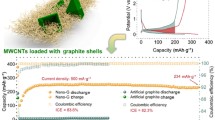Abstract
Background
Carbon nano wall (CNW) characterized by a large specific surface area were used, and graphite slurry was applied through a casting process to improve durability.
Methods
To improve adhesion between the current collector (copper foil) and CNWs, a titanium nitride (TiN) layer was deposited using the RF magnetron sputtering method. CNWs were then grown by injecting methane (CH4) and hydrogen (H2) using a microwave plasma enhanced chemical vapor deposition (PECVD) system. The casting process was performed by making the height of the graphite slurry uniform. Afterwards, heat treatment process was performed at 70℃, 75℃, and 80℃ on a hot plate to improve durability. Field emission scanning electron microscope (FE-SEM) and energy-dispersive X-ray spectroscopy (EDS) were used to confirm the presence of CNWs in the casting process. A Raman spectroscopy was used to analyze the structural properties of anode materials. The improvement in the durability of the anode material was confirmed by analyzing the electrochemical properties. Electrochemical impedance spectroscopy (EIS) and cyclic voltammetry (CV) were performed to characterize the lithium-ion battery.
Results
The cyclic voltammetry (CV) of the graphite slurry was measured at 20 cycles, which increased by about 8 cycles compared to other temperatures. As a result of electrochemical impedance spectroscopy, the Rct value was 25 Ohm at 75℃ heat treatment, which was about 4 times smaller than other temperatures.





Similar content being viewed by others
References
Jaguemont J, Boulon L, Dubé Y (2016) A comprehensive review of lithium-ion batteries used in hybrid and electric vehicles at cold temperatures. Appl Energy 164:99–114
Xuning Feng M, Ouyang X, Liu L, Lu Y, Xia X (2018) He Thermal runaway mechanism of lithium-ion battery for electric vehicles. A review; Energy Storage Materials 10:246–267
Sid Megahed B Scrosati (1994) Lithium-ion rechargeable batteries. J Power Sources 51:79–104
Hannan MA, Lipu MSH, Hussain A, Mohamed A (2017) A review of lithium-ion battery state of charge estimation and management system in electric vehicle applications. Renew Sustain Energy Rev 78:834–854
Wu YP, Rahm E, Holze R (2003) Carbon anode materials for lithium-ion batteries. J Power Sources 114:228–236
Xin Xu H, Tan K, Xi S, Ding D, Yu S, Cheng G, Yang X, Peng A, Fakeeh R, Vasant Kumar (2015) Bamboo-like amorphous carbon nanotubes clad in ultrathin nickel oxide nanosheets for lithium-ion battery electrodes with long cycle life. Carbon 84:491–499
Naoki Nitta G Yushin (2014) High-capacity anode materials for Lithium-ion batteries. Part Part Syst Charact 31:287–405
Ji L, Lin Z, Medford AJ, Zhang X (2009) Porous carbon nanofibers from electrospun polyacrylonitrile/SiO2 composites as an energy storage material. Carbon 47:3346–3354
Li P, Kim H, Myung S-T, Yang-Kook Sun (2021) Diverting exploration of Silicon Anode into practical way. A review focused on Silicon-Graphite Composite for Lithium-Ion Batteries. Energy Storage Materials 35:550–576
Kabir MM, Dervis Emre Demirocak (2017) Degradation mechanisms in Li-ion batteries. A state-of-the-art review. Energy Res 41:1963–1986
Joshua P, Pender G, Jha DH, Youn JM, Ziegler I, Andoni EJ, Choi A, Heller BS, Dunn PS, Weiss, Reginald M, Penner (2020) C. Buddie Mullins Electrode Degradation in Lithium-Ion Batteries. ACS Nano 14:1243–1295
Lee S, Kwon S, Kim K, Kang H, Ko JM, Choi W (2021) Preparation of Carbon Nanowall and Carbon Nanotube for Anode Material of Lithium-Ion Battery. Molecules 26(22):6950
Thi MT, Lee S, Choi W (2022) Adhesion and Stability increased Carbon Nanowall for the application to Lithium–ion batteries. J Electr Eng Technol 17:3613–3618
Jinpeng Nong W, Wei X, Song L, Tang J, Yang T, Sun L, Luo YW, Li C, Wei D (2017) Direct growth of graphene nanowalls on silica for high-performance photo-electrochemical anode. Surf Coat Technol 320:579–583
Cançado LG, Jorio A, Pimenta MA (2007) Measuring the absolute Raman cross section of nanographites as a function of laser energy and crystallite size. Phys Rev B 76:064304
Acknowledgements
This work was supported by the National Research Foundation of Korea (NRF) grant funded by the Korea government (MSIT) (No. 202200510001).
Author information
Authors and Affiliations
Corresponding authors
Additional information
Publisher’s Note
Springer Nature remains neutral with regard to jurisdictional claims in published maps and institutional affiliations.
Rights and permissions
Springer Nature or its licensor (e.g. a society or other partner) holds exclusive rights to this article under a publishing agreement with the author(s) or other rightsholder(s); author self-archiving of the accepted manuscript version of this article is solely governed by the terms of such publishing agreement and applicable law.
About this article
Cite this article
Kim, K., Kim, C., Kwon, S. et al. Graphite Slurry Heat Treatment Temperature for Improving the Durability of CNWs Anode Materials of Lithium-Ion Batteries. J. Electr. Eng. Technol. 19, 791–797 (2024). https://doi.org/10.1007/s42835-023-01580-2
Received:
Revised:
Accepted:
Published:
Issue Date:
DOI: https://doi.org/10.1007/s42835-023-01580-2




